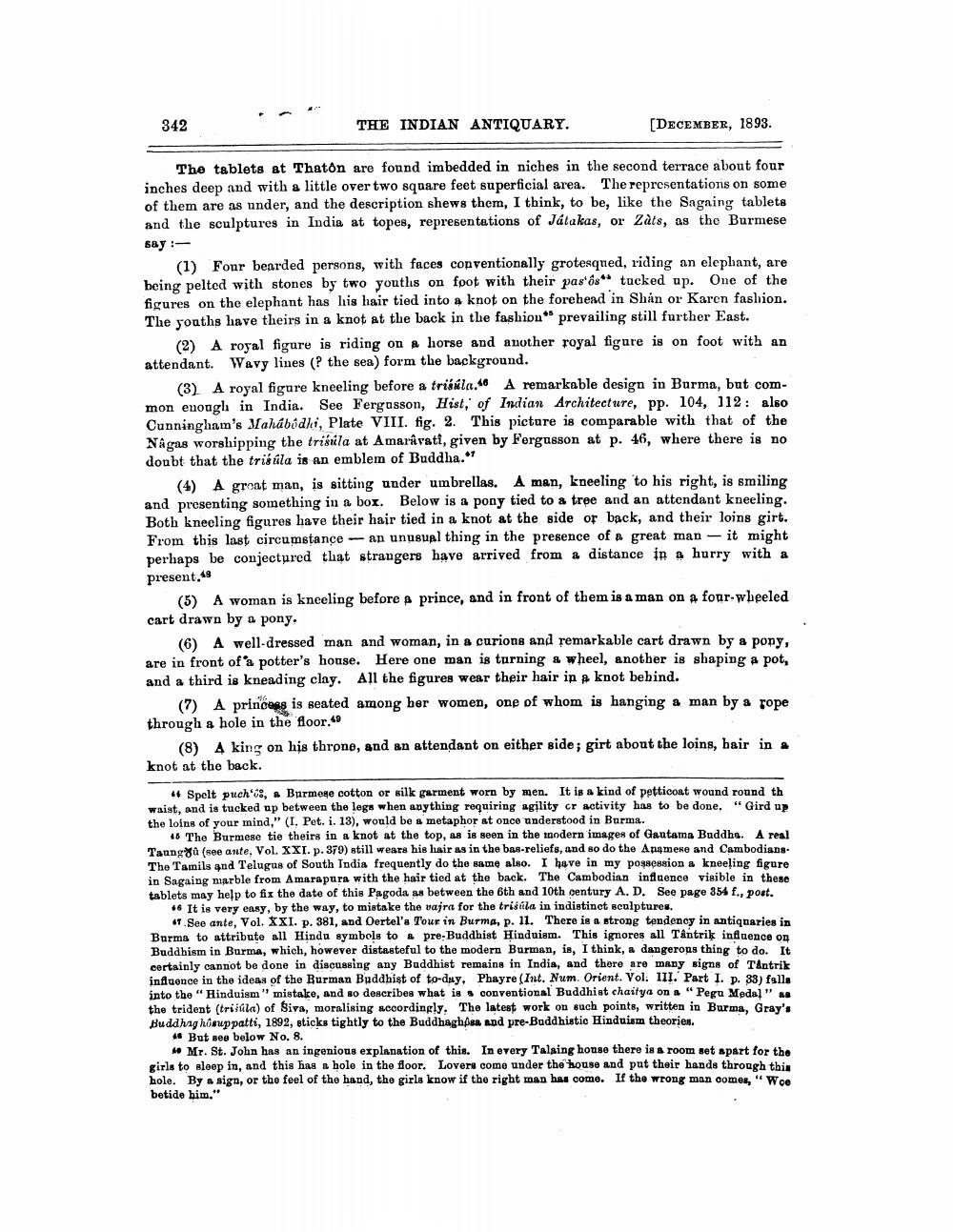________________
342
THE INDIAN ANTIQUARY.
[DECEMBER, 1893.
The tablets at Thaton are found imbedded in niches in the second terrace about four inches deep and with a little over two square feet superficial area. The representations on some of them are as under, and the description shews them, I think, to be, like the Sagaing tablets and the sculptures in India at topes, representations of Játakas, or Zats, as the Burmese say
(1) Four bearded persons, with faces conventionally grotesqued, riding an elephant, are being pelted with stones by two youths on foot with their pas'08tucked up. One of the figures on the elephant has his hair tied into a knot on the forehead in Shan or Karen fashion. The youths have theirs in a knot at the back in the fashion" prevailing still further East.
(2) A royal figure is riding on a horse and another royal figure is on foot with an attendant. Wavy lines (? the sea) form the background.
(3) A royal figure kneeling before a trisula.46 A remarkable design in Burma, but common enough in India. See Fergasson, Hist, of Indian Architecture, pp. 104, 112: also Cunningham's Jahábódki, Plate VIII. fig. 2. This picture is comparable with that of the Nágas worshipping the trišala at Amaravati, given by Fergusson at p. 46, where there is no doubt that the tristila is an emblem of Buddha."
(4) A great man, is sitting under umbrellas. A man, kneeling to his right, is smiling and presenting something in a box. Below is a pony tied to a tree and an attendant kneeling. Both kneeling figures have their hair tied in a knot at the side of back, and their loins girt. From this last circumstance - an unusual thing in the presence of a great man - it might perhaps be conjectured that strangers have arrived from a distance in a hurry with a
present,
(5) A woman is kneeling before prince, and in front of them is a man on a four-wheeled cart drawn by a pony,
(6) A well-dressed man and woman, in & curions and remarkable cart drawn by a pony, are in front of a potter's house. Here one man is turning a wheel, another is shaping a pot, and a third is kneading clay. All the figures wear their hair in a knot behind.
(7) A princeps is seated among her women, one of whom is hanging a man by a rope through a hole in the floor.
(8) A king on his throne, and an attendant on either side ; girt about the loins, hair in a knot at the back.
4 Spelt puch', Burmese cotton or silk garment worn by men. It is a kind of petticoat wound round th waist, and is tucked up between the legs when anything requiring agility cr activity has to be done. "Gird up the loins of your mind," (I. Pet. i. 13), would be a metaphor at once understood in Burma.
16 The Burmese tie theirs in a knot at the top, as is seen in the modern images of Gautama Buddha. A real Tanno (ante. Vol. XXI. p. 379) still wears his hair as in the bas-reliefs, and so do the Augmene and Cambodians. The Tamils and Telugus of South India frequently do the same also. I have in my possession a kneeling figure in Sagaing marble from Amarapura with the hair tied at the back. The Cambodian influence visible in these tablets may help to fix the date of this Pagoda as between the 6th and 10th century A. D. See page 354 f., post. .6 It is very easy, by the way, to mistake the vajra for the tristila in indistinct sculptures
See ante, Vol. XXI. p. 381, and Oertel's Tour in Burma, p. 11. There is a strong tendency in antiquaries in Burms to attributo all Hindu symbols to pre-Buddhist Hinduism. This ignores all Tantrik influence on Buddhism in Burma, which, however distasteful to the modern Burman, is, I think, a dangerous thing to do. It certainly onnnot be done in discussing any Buddhist remains in India, and there are many signs of Tantrik influence in the ideas of the Burman Buddhist of to-duy, Phayre (Ind. Num. Orient. Vol. III. Part I. p. 83) falla into the Hinduism" mistake, and so describes what is conventional Buddhist chaitya ona "Pegu Medal" as the trident (trifila) of Siva, moralising accordingly. The latest work on such points, written in Burma, Gray's Huddhaghónappatti, 1892, sticks tightly to the Buddhaghpa and pre-Buddhistic Hinduism theories.
46 But see below No. 8.
46 Mr. St. John has an ingenions explanation of this. In every Talaing house there is a room set apart for the girls to sloop in, and this has a hole in the floor. Lovers come under the house and put their hands through this hole. By a sign, or tho feel of the hand, the girls know if the right man has come. If the wrong man comes, " Wee betide him."




